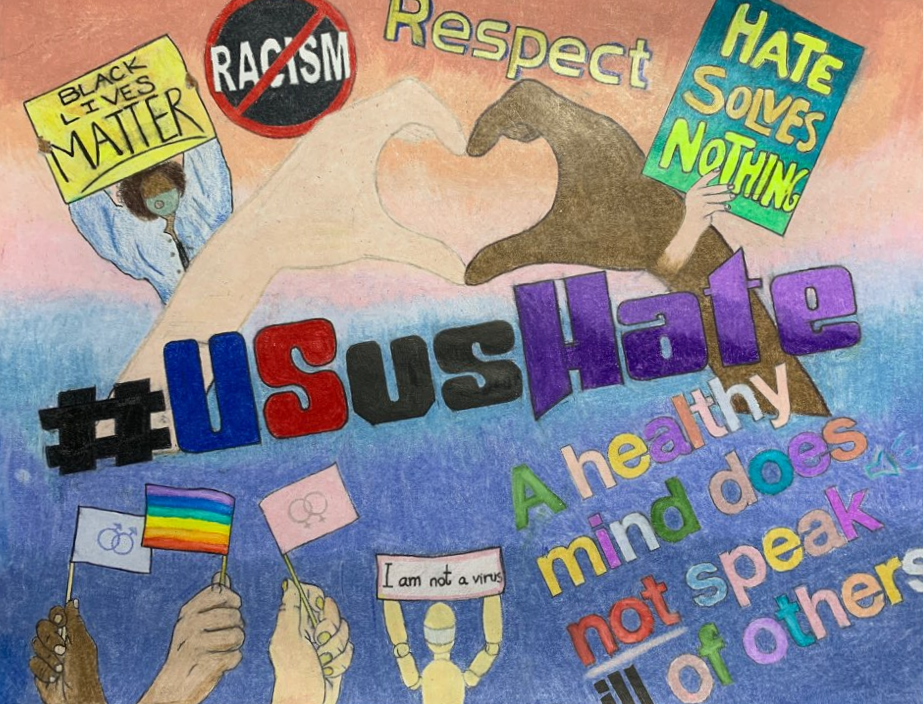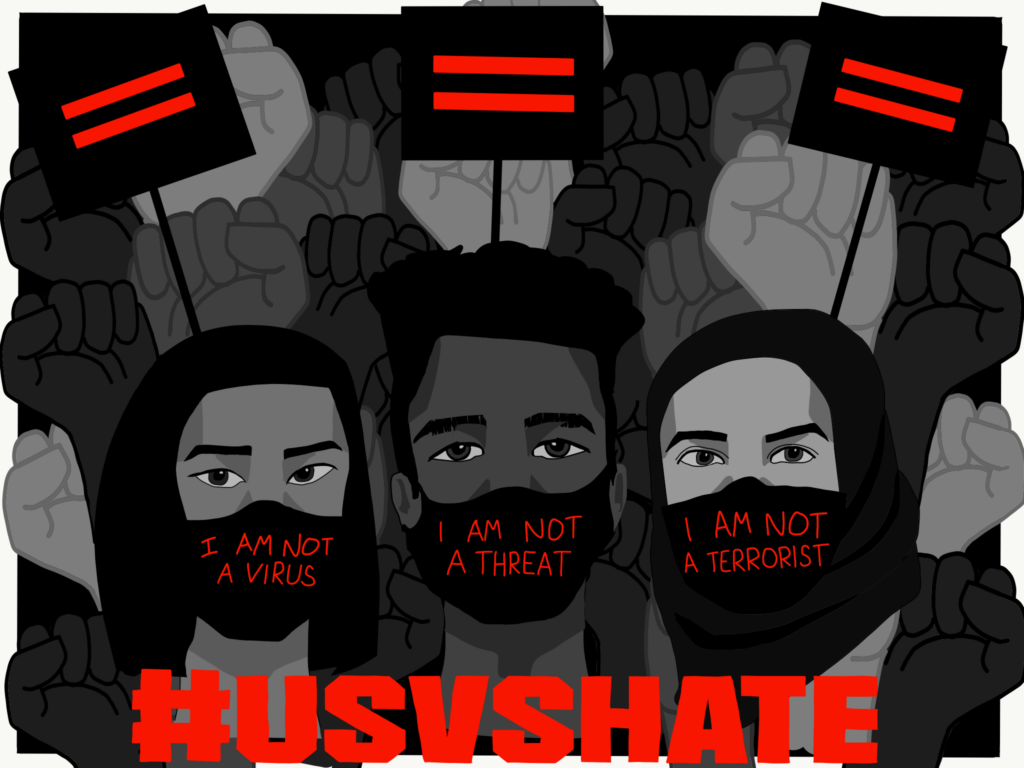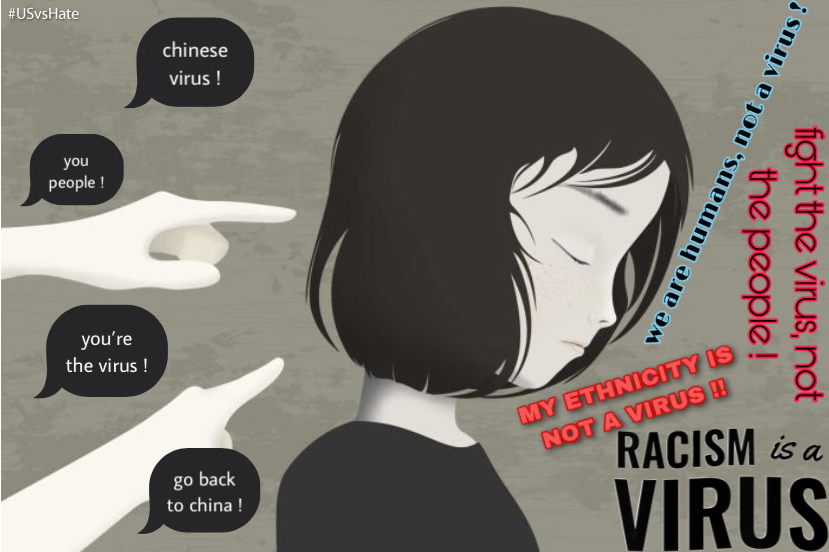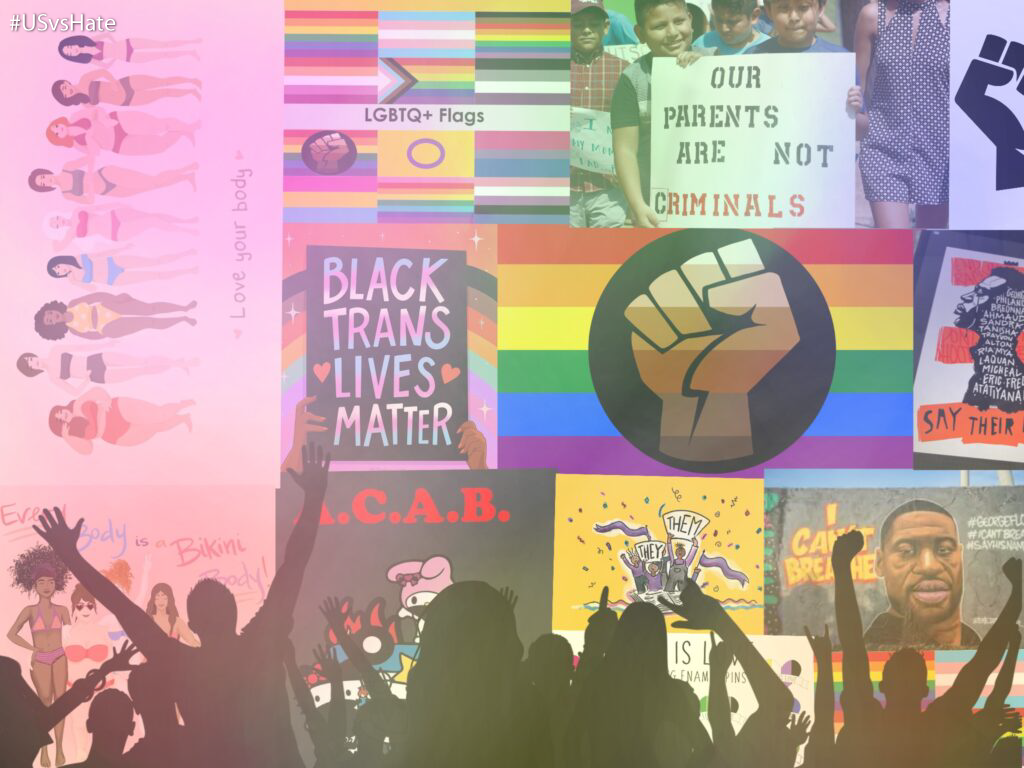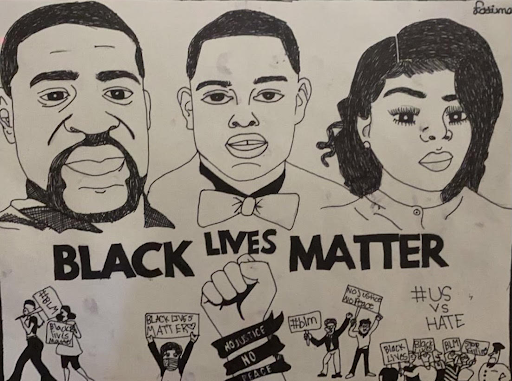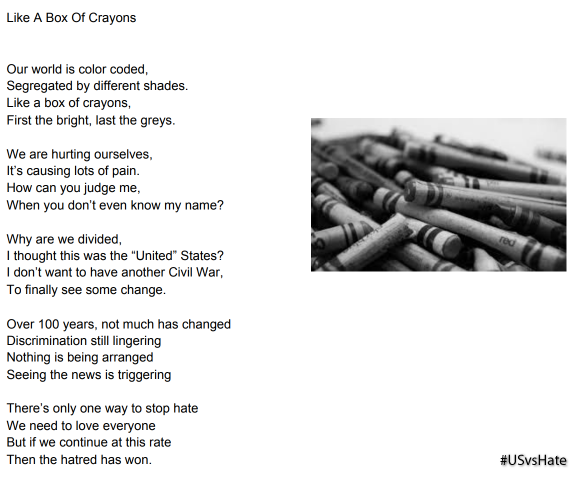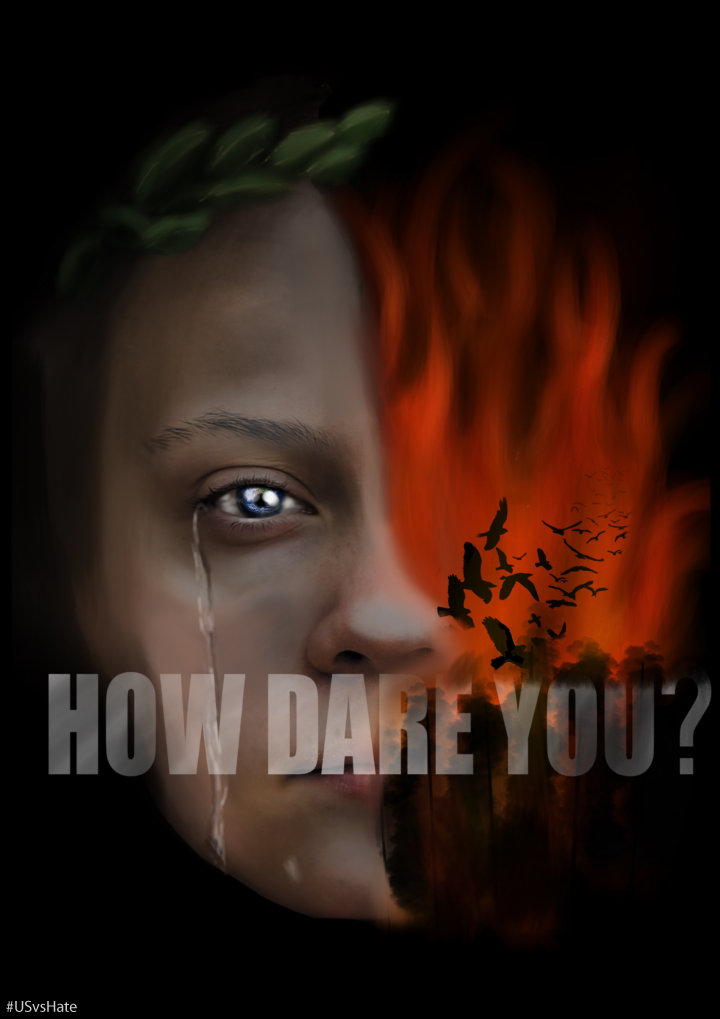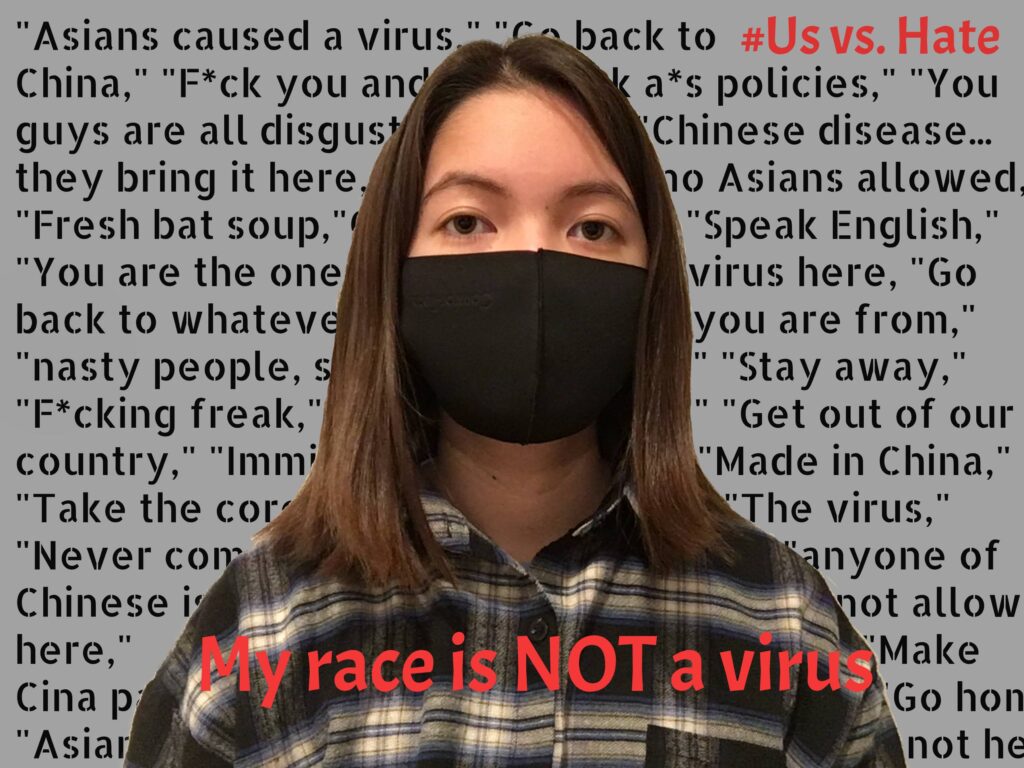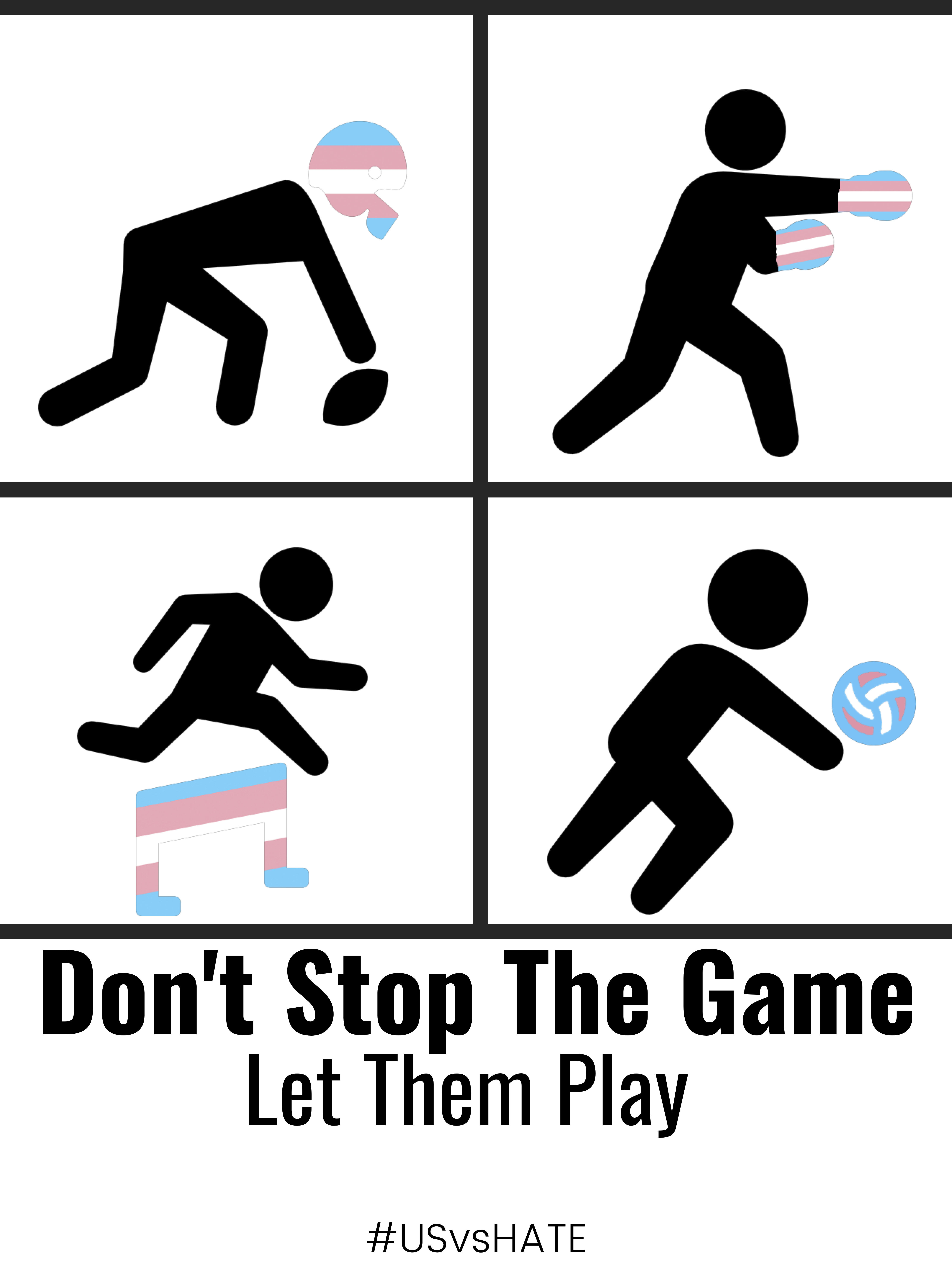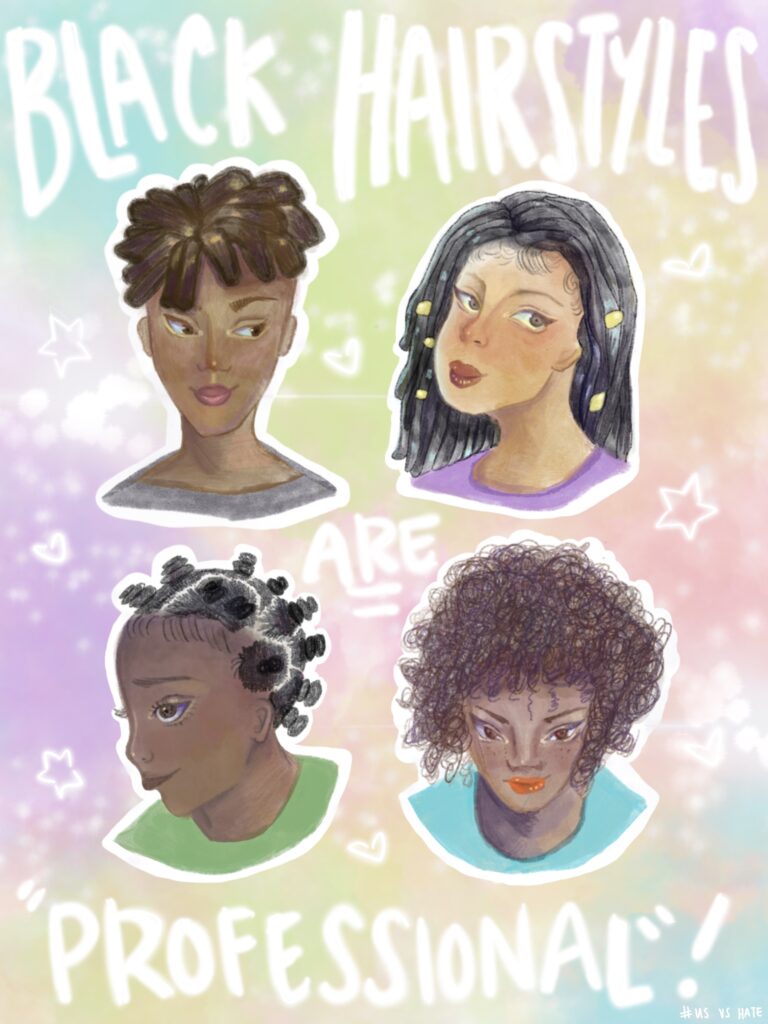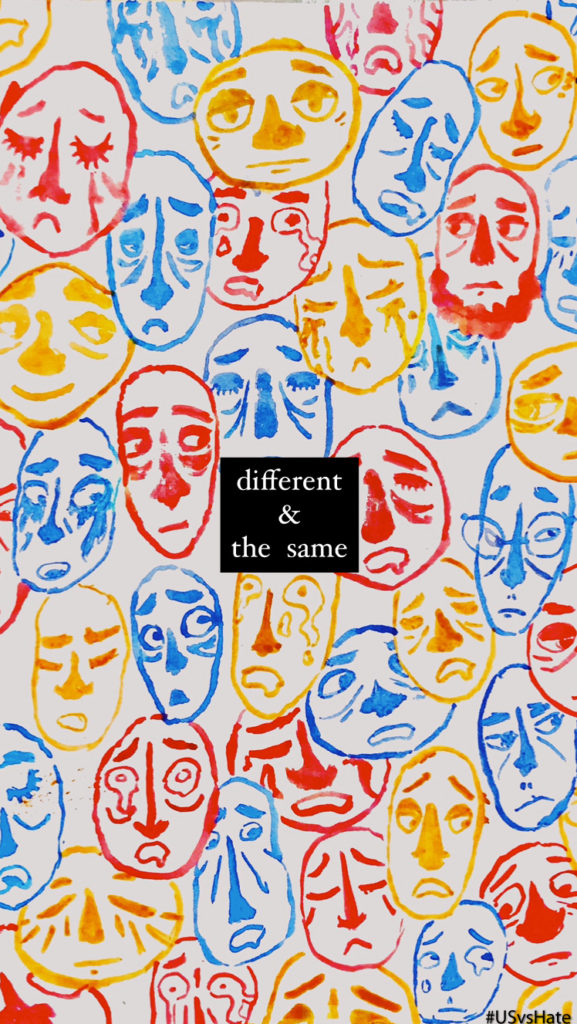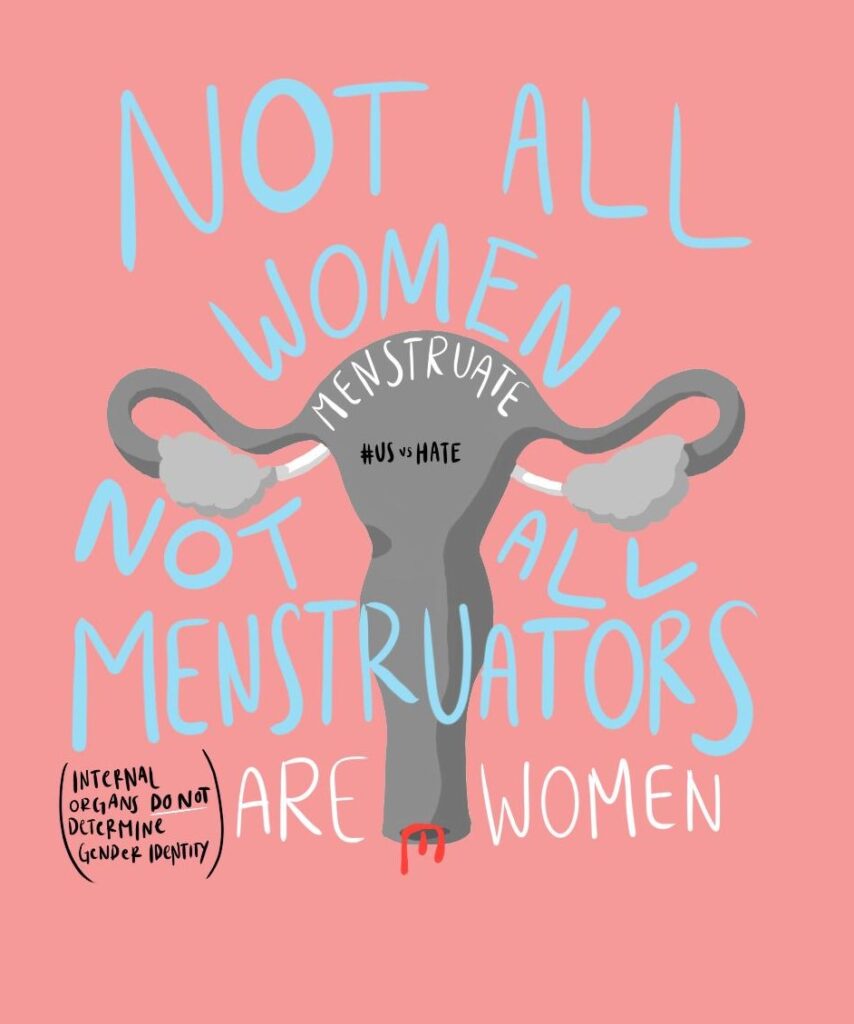Seowon, Grade 8, Fort Lee, NJ
Seowon’s teacher explains that students were given a choice in class to illustrate a graphic advertisement for any of the art contests currently being offered. “Almost ALL of our students chose to illustrate for the #USvsHate initiative. As the adviser of our Student Ambassadors team, I am thrilled that so many students are behind this campaign. Student Ambassadors are a group of students that are dedicated to preventing disharmony and bias behavior while helping to maintain cooperation and unity within the middle school student body. These students are role models for our school and help to promote a positive school climate. Many students have joined our ambassadors in the fight against hate and bias behavior making our school a true place of inclusion. We have proudly posted many of our anti-hate messages on our district website and created a “Kind Collage” in honor of World Kindness Day. There are some great kids in the world, and we are happy they feel welcome and safe at L.F.C.M.S.”
Lena, Grade 10, Chula Vista, CA
Student creator, Lena, explains, “I chose this specific anti-hate message because racial/ethnic inequality has been a long-running problem, and it has been a problem for way too long. It shouldn’t even exist, and the deaths of many African Americans such as George Floyd and harassment of other races during 2020 have inspired me to select this message, and I would like to encourage others to think about the message and share it all over social media and speak out. Spreading information is the most effective way to at least accentuate the problem.”
Her teacher, Kalie, further shared, “After many cycles of #USvsHate, I found myself having to simplify during distance learning. We discussed the amazing TED Talk “The Danger of a Single Story” by Chimamanda Ngozi Adichie and the implications within the novel we were studying (A Thousand Splendid Suns by Khaled Hosseini) and as well as in our own lives. I then gave students an assignment to do a bit of research related to one of the many forms of hate we see in the novel or current events. Students then had to explain why they chose that particular form of hate to inspire their work.”
Camila, Grade 11, North Andover, MA
Camila’s teacher shares, “As a school fortunate to have students learning in-person and online we spend class time discussing the making of purposeful and meaningful art. The students in our Drawing class were introduced to the “UsvsHate” website as part of a lesson on narrative drawing. Students were given the option to produce a narrative piece to reflect opposition to hate. That is the one rule of our art studio- no hate allowed.”
Olivia, Grade 10, Chula Vista, CA
Olivia’s piece highlights the hate she’s received as an Asian American regarding the Covid-19 pandemic and the awareness she wants others to have regarding anti-Asian racism and xenophobia. She writes, ” I chose this specific anti-hate message because I’m an Asian, who is not Chinese but have been accused of having the virus just because I am Asian. This experience has shown me how dull people’s minds can be and I feel like I should encourage people to understand how stereotyping Asians is racist. Degrading Asians because of their race is wrong and no one would want it done to them.”
Felix, Grade 7, National City, CA
Felix’ teacher shares that “during Thanksgiving week students were given opportunities to “reckon with our [country’s] history.” In doing so, the teacher hoped for students to “understand the realities of people’s lived experiences…and be better human beings.” Upon having deep conversations regarding prejudice, “students were encouraged… to reflect on the ways in which they can practice inclusion, anti-discrimination, anti-hate, and positive community building.” Felix’s piece is the outcome of the deep conversations and reflections students took part in preparing for the Thanksgiving holiday.
Gaby, Grade 11, Plantation, FL
In this essay, Gaby draws from personal experiences with homophobia. In the student’s own words, “The message behind my piece is to put in perspective how it feels like to be a victim of homophobia and over-sexualization. I know that in the LGBTQ community and society overall, it’s very hard to be bisexual because there is bias on both sides. This is an important topic which I feel most closely, and I don’t think is talked about enough. Biphobia can come from people on the outside who are just against same-sex relationships, people in the community who feel like it’s being greedy or indecisive, and specifically people who think it’s ok to oversexualize bisexuals just because they like more than one gender.” The image is intended for those who might not understand what it’s like to be a victim of homophobia and over-sexualization and for them to “feel” the pain experienced by Gaby daily. Gaby highlights that “if someone has never experienced something they shouldn’t judge others because of it, as they have never been in that position.” Through the usage of metaphor and irony, the hope is for readers to create a vivid image of Gaby’s lived experiences while promote acceptance of all forms of love.
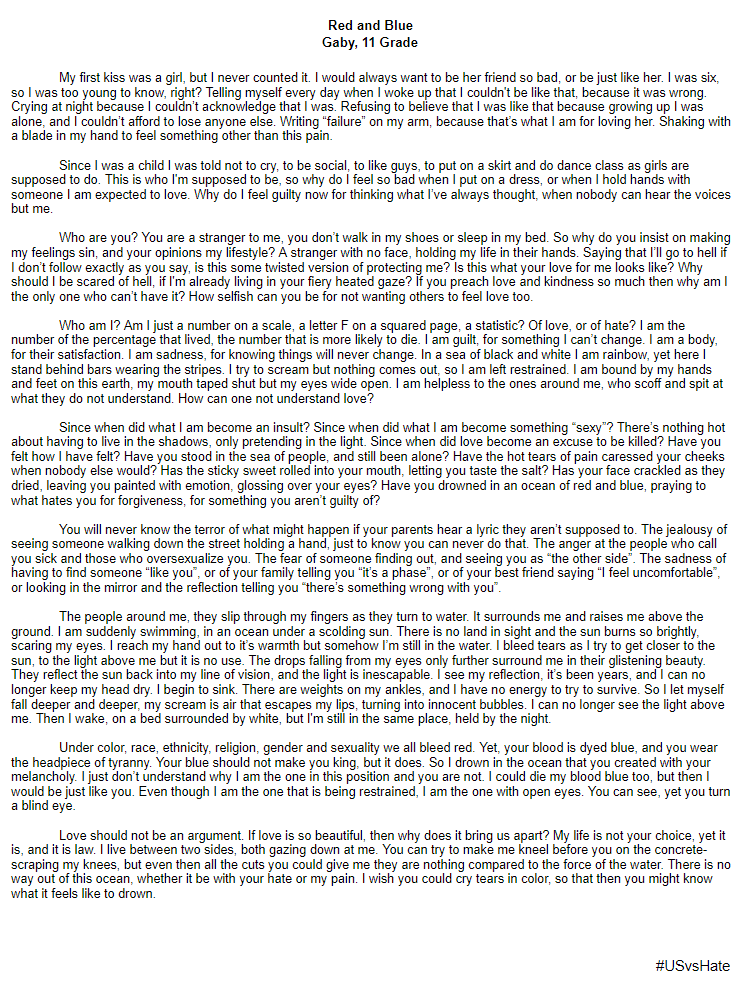
Fatima, Grade 9, La Jolla, CA
For Fatima, justice signifies equal treatment and access. She writes, “to me justice is when everyone is treated equally and people get what they need, what they deserve”. She chose to create and submit an art piece focused on the black community because “black people are getting killed and treated differently because of their skin color and need justice”. Through this art piece, Fatima hopes to promote awareness regarding the mistreatment of black communities and the necessity to stand up for justice.
Noel and Riley, Grade 11, La Habra, CA
In their poem, “Like a Box of Crayons,” Noel and Riley highlight the racism that continues to exist in today’s society. They write, “We chose racism because it is a big conflict in our country today. It is dividing our country in half. We think common perceptions of this topic is either people believe there is a lot of racism and the people who think racism isn’t a big problem.” Through their poem, they hope their readers see the importance of equality and are moved to not judge people based on appearances.
Steven, Grade 10, El Segundo, CA
Via the combined image of Antigone and Greta Thunberg, Steven attempts to convey that “no matter what gender or status you are, you can make some difference in the world.” On the left side of the poster, one is able to see Greta’s face. Steven explains that “It seems like she had experienced the wildfires because there is some dirt and cinders on her face. Moreover, she is crying because she realizes earth, our motherland, doesn’t feel right. She has a fever. As one looks closer, there is an inverted image of earth in her eye. When your eyes move up, you can see she is wearing a crown in Ancient Greek style which represents the honor of her and Antigone.” Steven placed the crown here as a symbol that can connect the central images of the art piece. On the right side, Steven has added a scene where crows are flying away from the burning forest. Steven explains that the “crows symbolize Antigone’s and Greta’s similar fate that they are both against the high authority and their approach to justice.” The slogan, “How dare you?”, is from Greta’s speech during the United Nations Climate Action Summit and it was added to stress the necessity for change and one’s role in the process of change.
Gabrielle, Grade 10, Chula Vista, CA
Gabrielle’s piece focuses on the increased hate Asians have been receiving due to the COVID-19 pandemic. The student writes, “I care about this specific anti-hate message because racism towards Asians has become so casual in recent times, and no one I know has publicly talked about it. It does not help with people referring to COVID-19 in a way that is derogatory toward Asians, as well as the president of a major country contributing to it.” Through this message, Gabrielle hopes to “spread awareness in order for the racism to stop.”
College-level Winners
Rhys Cambell, Sociology, UC San Diego
“I wanted to make a poster that encourages the inclusion of transgender students in sports. There is a lot of disagreement over whether trans students should be allowed to play with the gender they identify with or if they should be forced to play based on their biological gender. Schools have tended to side with the parents who complain, even going so far as to imply that Title IX does not protect trans athletes. Because of this, the students have either been bullied out of playing by adults or have been forced to pick between honoring their identity and playing sports. Regardless of identity, that is undeniably wrong and contributes to students not feeling safe at school. Every student deserves the equal opportunity to play and be a part of the team while remaining true to who they are. Schools have the power to keep the game going and let trans athletes play, and it is important for us to show our support for that. We need schools to make the message clear: hate will not be tolerated on or off the field.”
Kaitlin Gundersen, English Literature, UC San Diego
“I really want to be a teacher in the close future. I remember the first time I saw an article about a young Black girl getting sent home from school for having ‘inappropriate’ hair for school. The hair in question was box braids, a protective hairstyle for natural Black hair. I was infuriated, and in such disbelief. I did a lot of research on how prevalent discrimination against ethnic hairstyles is, and it only got worse and worse. Many Black people, Black women in particular, face workplace harassment and/or discrimination because of the way their hair naturally is. A while back, people began to notice that the ‘unprofessional hairstyles’ search yields a myriad of Black hairstyles in Google Images. This sparked a lot of controversy, but I think there is nothing to be debated here. Hair has nothing to do with one’s ability to excel in work or school. One’s natural hair, and the hairstyles that help protect them, should not be deemed unprofessional. We need to stop punishing POCs for how their hair naturally is.”
Tina Truong, Education Sciences, UC San Diego
“I created a poster titled ‘Let’s Empower.’ This creation addresses how students are too often misrepresented and misunderstood due to their intersecting identities. This poster represents how school, a major institution, must refuse racism, homophobia, antisemitism, and any and all biases and injustices. Every student deserves access to proper education and various opportunities, as well as being treated fairly in school and society overall. This can start with educators. Instead of ignoring different identities and putting students into a box, educators should comprehend and work with the diversity of minority youth. By implementing a culturally competent system, teachers will be able to work with a diverse group of people to promote an equitable and inclusive environment. It is essential for administrators to empower students to embrace their cultural identities and give students agency so they can make choices of their own and execute their adjustments in school to meet their own needs. All students have the want to succeed and when it comes to education, it must be equitable to all.”
Brad Duran, Mathematics and Economics, UC San Diego
“I intend my message to highlight the importance of intersectionality in the fight for equality and equity. Black and Brown trans women have been at the forefront of the fight for LGBT and women’s rights. It is of utmost importance that those with privilege stand up and do their part in the fair for the fair treatment of marginalized communities.”
Anonymous Undergraduate Student, Human Biology, UC San Diego
“I honestly struggled to pick a message because I feel like there is so much to say. I started and erased a lot because I have anxiety about how messages are received. But I remembered how a certain author recently invalidated the identity of trans women and referred to them not being actual women because they do not menstruate. This angered me that an author whose work carried me through some of the roughest points of childhood would spread such a hateful message. Women are women. Genitals and internal organs do not define gender identity. Women do not owe society femininity either. It’s important we respect the identity people have because that is who we are.”
